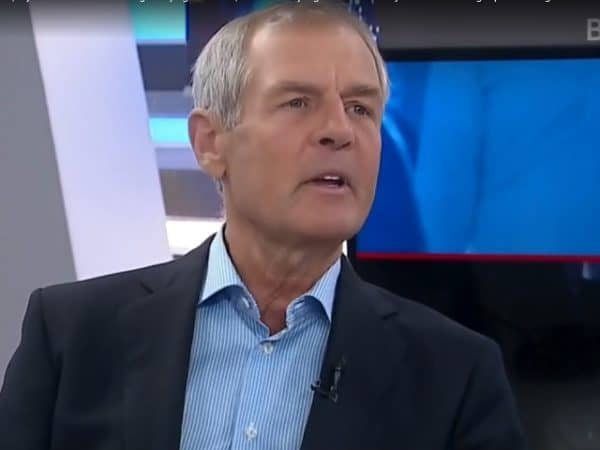
If you’re looking for a good long-term infrastructure play, John Zechner says you should be thinking about the Canadian telecom companies including Rogers Communications (Rogers Stock Quote, Charts, News, Analysts, Financials). Zechner sees Rogers along with the other big names to be trading relatively cheap considering the value built into their long-term capex investments.
“We still own Rogers. I’m disappointed in the performance of the telecom carriers in general and, obviously, Rogers got hurt a little bit when people worried about the debt they’re taking on to buy Shaw Communications,” said Zechner, chairman of J. Zechner Associates, who spoke on BNN Bloomberg on Monday.
“That’s a big concern, but everybody wants long-lived infrastructure assets and they talk about the towers and everything else in terms of utilities and real estate assets and everything else, and I keep looking the telecom companies,” he said.
As per usual, Canada’s Big Three telcos Rogers, BCE (BCE Stock Quote, Charts, News, Analysts, Financials TSX:BCE) and Telus (Telus Stock Quote, Charts, News, Analysts, Financials TSX:T) have been charting similar paths over the past year and a half, with all of them sagging through the first half of 2020 before starting to pick it up along the back end of the year and into 2021.
They’re all in the black this year. Rogers is currently up eight per cent year-to-date but it’s still well off its pre-COVID highs. BCE is up 18 per cent and currently right back to where it was pre-COVID. Meanwhile, Telus is up 14 per cent year-to-date and is now about four per cent above its February 2020 high.
The proposed merger between Rogers and Western Canada-focused Shaw Communications (Shaw Communications Stock Quote, Charts, News, Analysts, Financials TSX:SJR.B) has been on the minds of Rogers shareholders, with the blockbuster $26-billion deal still facing a number of regulatory hurdles. Canada’s Competition Bureau, the Canadian Radio-television and Telecommunications Commission (CRTC) as well as Innovation, Science and Economic Development Canada (ISED) are all scrutinizing the merger for its potential impacts on pricing for customers, competition and innovation within Canada’s telecom sector.
Regardless of the outcome, Zechner says the investments currently being made by all the major telcos in building out their wireless and broadband networks is substantial — and not to be overlooked by investors seeking a long term value play.
“What they’ve invested in 5G and infrastructure and licenses and everything else, these things are really long term infrastructure assets for the next generation of communication,” Zechner said.
“You can get them at 7x operating cash flow versus 15x to 20x for a lot of these other [companies]. I just think this is a bargain that’s not recognized,” he said.
“There’s competitive risks, there’s regulatory risk, I understand that, but I just think BCE, Telus, Rogers, Quebecor, across the board, we own all of them. I think they’re all very cheap and I think there’s decent growth ahead and they’re still under-appreciated,” he said.
“They pay decent dividends and have some free cash flow, although Rogers won’t have as much free cash flow, obviously, with the debt they’re going to take on to buy Shaw,” Zechner said.
By the terms announced in March of this year, Rogers is offering to pay Shaw shareholders $40.50 per share in cash for a 70-per-cent premium to SJR’s share price at the time of announcement. The deal would also include Rogers taking on about $6 billion in debt from Shaw, while Rogers has said the deal is not conditional upon new financing, as it has already secured the required cash.
By comparison, Rogers’ dividend is well below the other two and currently sits at a yield of 3.1 per cent versus BCE at 5.4 per cent and Telus at 4.5 per cent.
Rogers last reported quarterly financials in July where its second quarter top and bottom numbers arrived in-line with consensus estimates. Rogers’s Q2 featured revenue of $3.58 billion, up from $3.16 billion a year ago and a hair above analysts’ average estimate at $3.56 billion. Earnings were $302 million or adjusted at $0.76 per share compared to the expected $0.77 per share.
Rogers said its wireless postpaid net subscriber additions totalled 99,000, while internet net subscriber adds were at 9,000. Free cash flow was $302 million for the quarter and cash flow from operations was $1.016 billion.
“Our solid performance in the second quarter is a result of strong execution across each of our business units as the economy continues to recover from pandemic lockdowns,” said Joe Natale, President and CEO, in a press release.
“We saw our Wireless service revenue return to year-over-year growth and we delivered strong Wireless postpaid subscriber net additions. Our Cable business continued to deliver consistent top- and bottom-line growth and our Sports and Media business is seeing advertising revenue recover,” Natale said.
Leave a Reply
You must be logged in to post a comment.






 Share
Share Tweet
Tweet Share
Share




Comment